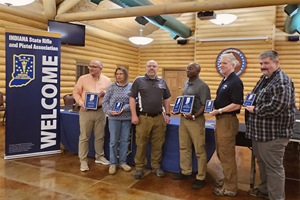In the lead up to the “most important election in our lifetimes” I’ve covered a lot of subjects. From abuses by executive agencies, to our Supreme Court (how we got here, and how we have the current Justices,) the end of the (quote-unquote) assault weapons ban over 20 years ago, and the four boxes of liberty. All of these have one thing in common: elections have consequences.
It is important for all of us (law abiding gun owners) to remember the eloquent words of Article 1, Section 32 of the Indiana State Constitution, “The people shall have a right to bear arms, for the defense of themselves and the State.” The Bill of Rights was only 25 years old when Indiana became a State. Those 17 words written in Corydon (the first State Capitol) show that the early Hoosiers understood what the 2nd Amendment truly stands for. \Since the 2nd Amendment was based on the British Bill of Rights from 1689, it is also a reminder of the slippery slope we all must avoid.
Yes, I will admit we beat the British in two wars and bailed them out in both World Wars. I will also recognize that much of our law in the United States comes from British Common Law. Much of our 1st, 2nd, and 8th Amendments are clearly in the British Bill of Rights, from King William III and Queen Mary II in 1689. While William and Mary didn’t give the right to bear arms to all citizens (or subjects in their case, we fixed that) our founders remedied the right to arms for all with our 1st Amendment.
In a period of 93 years, Great Britain went from having incredible freedoms concerning the right to keep and bear arms, to self-defense being against the law. This wasn’t overnight, it wasn’t all at once. It was a slippery slope that looks incredibly similar to our own fight to maintain our rights.
In 1903, the Pistols Act forbid the sale of handguns to minors or felons. That seems reasonable enough. To make sure it is enforced, a licensing system was introduced.
In 1914 with the outbreak of WWI, “temporary” gun control measures were introduced for “national security” reasons, of course. As Economist Milton Friedman would state years later, “Nothing is more permanent than a temporary government program.”
By 1920 the war had ended, but there were more threats from revolution (the Bolsheviks had just overthrown the Czar in Russia) and criminals. The Firearms Act of 1920 required a “good reason” to possess a handgun or rifle. A good reason was self-defense.
In 1936 fully automatic firearms were outlawed in Great Britain. At the time there was no evidence that a machine gun had ever been used in a crime in Great Britain, since they didn’t have Prohibition which led to the rise of criminals using automatic weapons like we had in the US. It seemed that British civilians didn’t have a “need” for automatic weapons. Obviously British gun owners didn’t realize they were on a slope, and a slippery one at that.
In 1936 the British Police (who issued the firearms licenses) started enforcing firearms storage requirements. There was no law, the administrative state just did it through a rules process. Does this sound familiar?
In 1940, the British Expeditionary Force evacuated from Dunkirk. The Germans occupied France and the English Channel was all that was between England and an invasion. Sporting shotguns (which required no license) were not the firearms required by the Home Guard. Magazines including the NRA’s flagship publication The American Rifleman had articles such as “Send a Gun to Defend a British Home.” The NRA shipped 7,000 guns to Great Britain. Prime Minister Winston Churchill personally supervised the delivery of these arms to the Home Guard in coastal towns.
After the war these guns were collected and destroyed. In 1946, self-defense was no longer a valid reason to receive a firearms license. The slippery slope was starting to look more like an icy cliff.
Beginning in 1967, a certificate was required to purchase a shotgun. In 1976 the transfer of firearms to heirs became impossible because of restrictions on those yet to be born.
In 1996, handguns larger than .22 caliber were banned. All law-abiding gun owners had licenses to possess their handguns, so the government knew who had all the handguns. Registration has always led to confiscation.
Always remember, we have a Bill of Rights, not a Bill of Needs. A lesson to be learned from what happened in Great Britain was the refusal of the sport-shooting organizations (such as the Clay Pigeon Shooters Association, the National Small Bore Rifle Association, and the United Kingdom Practical Shooting Association) to support those who saw the importance of handguns for self-defense. It was too late when the British gun owners realized the importance of “united we stand.”
In the lead up to the recent pistol brace court battle with the ATF, I said many times that I would support those with braced-pistols. I own none, but I know the powers that be will come after the guns I do own next.
In an essay written by Joseph Olson and David Kopel titled “All the way Down the Slippery Slope,” the writers identified factors leading to the loss of gun rights (my comments in parenthesis.)
- Media sensationalism about abuses of the right and media hostility toward the exercise of the right. (WOW do we see that a lot.)
- Technological changes that introduce new and socially controversial ways of exercising the right. (Semi-automatic firearms have been around since the late-19th century, yet these are vilified. If the Police carry them? It seems prudent we should as well.)
- Political leaders gaining political benefits (such as diverting the public from the death penalty, or demonstrating the leader’s compassion) from attacks on the right. (Many with taxpayer-funded security would disarm the rest of us if they could.)
- The production of deliberately misleading data by the government in support of restrictive legislation. (Dr John Lott has recently taken the FBI to task on their under-reporting of armed citizens stopping mass-shootings, as well as under-reporting violent crimes. The FBI then quietly corrected the data to show an increase in crime when a decrease had been touted by the Biden Administration.)
- The government’s loss of trust in ordinary citizens. (Remember that Attorney General Merrick Garland called those who speak in opposition at school board meetings, domestic terrorists.)
My comments were all based on things that have happened in the last four years. The slippery slope points made by Olson and Koper were about the British losing their gun rights and was written 25 years ago.
If everything goes right, you’ll be reading this within a week of the election. We all know gun owners, ask them if they’ve voted. If you know gun owners in other States, ask them the same question. Elections do have consequences.
Kelly Myers, ISRPA Government Affairs Co-Director


